There are 1,800 species of earthworms grouped into five families and distributed all over the world. Some grow as long as 3 feet, while others are only a few tenths of inches. We call them nightcrawlers, field worms, manure worms, red worms and some people just say "yuck."
Numerous investigators have pointed out the beneficial effects of earthworms on soil properties. One of the first of these observers was Charles Darwin who published Earthworms and Vegetable Mould in 1881. He remarked on the great quantity of soil the worms can move in a year. He estimated that the earthworms in some of his pastures could form a new layer of soil 7 inches thick in thirty years, or that they brought up about 20 tons of soil per acre, enough to form a layer 0.2 inch deep each year.
Earthworms, where they flourish, are important agents in mixing the dead surface litter with the main body of the soil. They drag the leaves and other litter down into their burrows where soil microorganisms also begin digesting the material. Some earthworms can burrow as deeply as 5 to 6 feet, but most concentrate in the top 6 to 8 inches of soil.
The worm subsists on organic matter such as leaves and dead roots near the soil surface. The earthworm ingests soil particles along with the organic matter and grinds up the organic matter in a gizzard just as a chicken does. This is excreted in what we call worm casts. The castings differ chemically from the rest of the soil, as they are richer in nitrogen, potassium and other mineral constituents.
Castings are a natural by-product of worms. When added to normal soils in gardens or lawns, they provide the same kinds of benefits as other bulky organic fertilizers. Castings today are not commonly used as fertilizer by commercial plant growers because of their cost relative to other fertilizers. However, castings are used by some organic growers and are sold commercially as a soil amendment or planting medium for ornamental plants grown in pots.
The physical soil churning process also has several important effects:
- Organic residues are more rapidly degraded with the release of elements such as nitrogen, sulfur and other nutrients.
- Some of the inorganic soil minerals tend to be solubilized by the digestive process.
- Extensive burrowing improves soil aeration.
- Burrowing can improve water penetration into soils
- The earthworm carries surface nutrients from the soil surface and imports them into the root zone of the plant.
Although earthworms are considered beneficial to soil productivity, few valid studies have been made to determine whether their presence will significantly improve plant growth. This may seem odd since many of us have learned from childhood that worms are good. It is something like the chicken and the egg analogy. The conditions that are conducive to earthworms are also ideal for plants. Both plants and worms need temperatures between 60 and 100 degrees F for good growth; both need water, but not too much or little; they both require oxygen for respiration; and they do not like soils that are too acid or basic or too salty. By correcting soil conditions that are unfavorable for one will also improve the outlook for the other. The earthworm is a natural component of the soil population. If the soil is properly managed this natural population will thrive. In this sense, the presence or absence or earthworms can be an indicator of the "fertility" of one's soil.
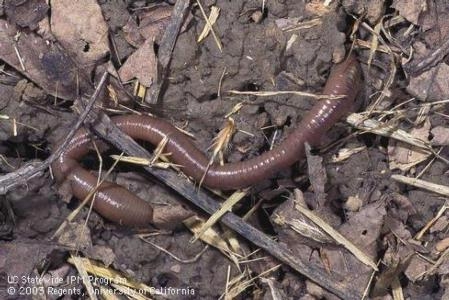
earthworm
Posted on
Tuesday, May 2, 2023 at
11:51 AM
Focus Area Tags: Agriculture
In any single location, there are typically more earthworms and more earthworm species found in temperate regions than in the tropics. Global climate change could lead to significant shifts in earthworm communities worldwide, threatening the many functions they provide. These are the two main results of a new study published in Science. The research was led by scientists from the German Centre for Integrative Biodiversity Research (iDiv) and Leipzig University. They brought together 140 researchers from across the globe to compile the largest earthworm dataset worldwide, encompassing 6928 sites in 57 countries.
Earthworms can be found in many ecosystems worldwide. Where the soil is not frozen (permafrost), too wet, acidic, or completely dry (deserts), earthworms substantially shape the way ecosystems function. They dig holes, mix soil components and eat organic debris. By doing so, they drive a wide range of ecosystem services, such as nutrient provision, freshwater supply, carbon storage, climate mitigation or seed dispersal. It is for these reasons that earthworms are considered highly important "ecosystem engineers". This importance is also reflected by the large amount of biomass that accumulates in earthworms: in fact, the total earthworm biomass is often larger than that of all mammals living in the same area.
Although the great impact of earthworms on ecosystems and the services they provide to people are well known, little is known about how they are distributed on a global scale. "Researchers have known for decades that for any given area in the tropics we would usually expect more species than in the same sized area in temperate regions," says first author Dr Helen Phillips, researcher at the German Centre for Integrative Biodiversity Research (iDiv) and Leipzig University (UL). "But until now, we had been unable to quantitatively investigate the same global patterns for earthworms, as there was no global earthworm dataset."
Phillips and her colleagues aimed to create a global map using as much data on earthworm diversity, abundance and biomass as possible. Working as part of an international sDiv (iDiv's synthesis centre) working group, Phillips, senior authors Nico Eisenhauer (iDiv, UL) and Erin Cameron (Saint Mary's University), as well as members of the working group contacted earthworm researchers from around the world and asked them to provide their data for compiling a whole new global earthworm dataset with open access for everyone. "Initially, we thought this is a crazy idea. But then, we were impressed how many colleagues were highly motivated to share their data for this exciting endeavour," says senior author Prof Nico Eisenhauer, research group head at iDiv and Leipzig University. "We basically started from scratch in 2016 - only a couple of years later we could publish one of the largest datasets on soil biodiversity. This is an amazing achievement of the lead author Helen Phillips and the many scientists that trusted in us."
The results of this huge effort show that patterns of belowground biodiversity do not match those observed for organisms living aboveground. Plant, insect or bird diversity (number of species within any given area) typically increases from high to low latitudes, meaning that the number of species is highest in the tropics. For earthworms, however, the researchers found the opposite pattern. In fact, highest local earthworm diversity was found in Europe, northeastern USA and New Zealand. Similar patterns were found for earthworm abundance (number of individuals per area) and earthworm biomass (mass per area) - also showing highest values in temperate regions.
At the same time, earthworm species in the tropics seem to have smaller distribution ranges. "In the tropics, if you drive just a few kilometres, you may find a whole new set of earthworm species, while in the colder regions they remain more or less the same," says Helen Phillips. "This could mean that while there are few species found in a single location in the tropics, the total number of species across the whole region may in fact be extremely high. But we don't know yet." The main reason for this uncertainty is that many tropical earthworm species have not yet been described. Thus, earthworms identified at different locations could belong to the same species or not - a question to be resolved.
The researchers also assessed which environmental factors drive the number of earthworm species, as well as their abundance and biomass. They found that factors related to precipitation and temperature had the largest effects. "Based on these strong climate effects, we conclude that climate change could cause shifts in earthworm communities and change the functions and services ecosystems provide," says Nico Eisenhauer. "Given their role as ecosystem engineers, we are concerned about potential cascading effects on other organisms like microbes, soil insects and plants."
The results of the study have implications for conservation priorities: Biodiversity is usually an important criterion for the selection of protected areas. However, focusing only on aboveground diversity may result in insufficient protection of earthworms. Thus, belowground biodiversity needs to be included for a complete assessment - enabling conservationists to identify the planet's true biodiversity hotspots. "It's time for a paradigm shift in the conservation of biological diversity - because they are mostly dwelling in the soil, we easily forget about the amazing creatures under our feet," says Nico Eisenhauer. "Earthworms may be cryptic and may not have the charisma of a panda bear, but they are extremely important for other organisms and the functioning of our ecosystems."
news release
Higher local earthworm diversity in temperate regions than in the tropics
German Centre for Integrative Biodiversity Research (iDiv) Halle-Jena-Leipzig
Image: Infographic depicting main results of new Science publication. (Picture: Fuse Consulting)
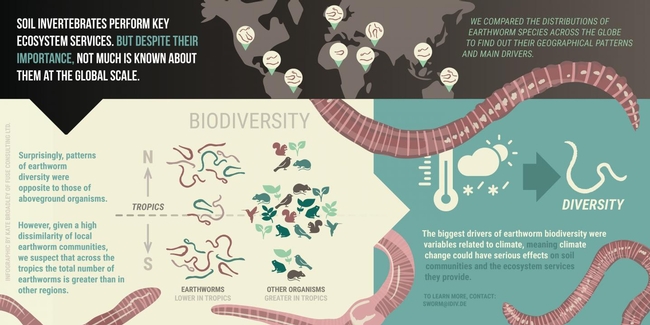
worm diversity
Posted on
Monday, November 25, 2019 at
11:30 AM
ITHACA, NY, July 22, 2019 - Protecting crops from pests and pathogens without using toxic pesticides has been a longtime goal of farmers. Researchers at Boyce Thompson Institute have found that compounds from an unlikely source - microscopic soil roundworms - could achieve this aim.
As described in research published in the May 2019 issue of Journal of Phytopathology, these compounds helped protect major crops from various pathogens, and thus have potential to save billions of dollars and increase agricultural sustainability around the world.
Led by BTI Senior Research Associate Murli Manohar, a team around Professors Daniel Klessig and Frank Schroeder investigated the effects of a roundworm metabolite called ascr#18 on plant health.
Ascr#18 is a member of the ascaroside family of pheromones, which are produced by many soil-dwelling species of roundworms for chemical communication.
The researchers treated soybean (Glycine max), rice (Oryza sativa), wheat (Triticum aestivum) and maize (Zea mays) plants with small amounts of ascr#18, and then infected the plants with a virus, bacteria, fungus or oocmycete.
When examined several days later, the ascr#18-treated plants were significantly more resistant to the pathogens compared with untreated plants.
"Plant roots are constantly exposed to roundworms in the soil, so it makes sense that plants have evolved to sense the pest and prime their immune systems in anticipation of being attacked," says Schroeder.
Because they boost plants' immune systems instead of killing pests and pathogens, ascarosides are not pesticides. As a result, they are likely to be much safer than many current means of pest and pathogen control.
"Ascarosides are natural compounds that appear to be safe to plants, animals, humans and the environment," says Klessig. "I believe they could thus provide plants more environmentally friendly protection against pests and pathogens."
In previous work, Klessig and Schroeder demonstrated that ascr#18 and other ascarosides increased resistance against pest and pathogens in tomato, potato, barley and Arabidopsis.
"By expanding the work to major crops, and concentrating on their most significant pathogens, this study establishes the potential for ascarosides to enhance agriculture production worldwide," says Klessig.
Indeed, rice is the world's most important staple food for nearly half of the global population. Ascr#18 provided protection against Xanthomonas oryzae pv. oryzae, a bacterium that causes yield losses of 10-50% in Asian countries.
Wheat is close behind rice in importance as a food staple, and ascr#18 protected it against Zymoseptoria tritici, a fungus that is one of the most severe foliar diseases of the crop.
Maize is the most widely grown grain crop throughout the Americas with great importance for food, biofuel and animal feed. Ascr#18 provided protection against Cochliobolus heterostrophus, a fungal pathogen that causes southern corn leaf blight.
Soybean is a major high-protein, oil-rich seed crop used as a food source for humans and animals. Ascr#18 protected soybeans against Phytophthora sojae, an oomycete that can kill infected plants in days, as well as the bacterial pathogen Pseudomonas syringae pv glycinea and Soybean Mosaic Virus.
Extremely small concentrations of ascarosides are sufficient to provide plants with resistance against pathogens. Interestingly, the optimal concentration appears to be dependent on the plant species and not the pathogen.
The researchers believe the reason that different plant species have different optimal dosages is likely related to the plant cell's receptors for ascr#18. Different plant species may express different amounts of ascr#18 receptors, and receptors may have varying affinities for ascarosides. Such differences would affect the amount of ascr#18 needed to trigger the plant's immune systems.
The group is now working to determine the molecular mechanisms of how ascarosides prime the plant's immune systems.
These discoveries are being commercialized by a BTI and Cornell-based startup company, Ascribe Bioscience, as a family of crop protection products named PhytalixTM.
"This work is a great example of how the Institute is leveraging our technology through new start-up ventures, an important strategic initiative at BTI," says Paul Debbie, BTI's Director of New Business Development. "The Institute is proud of the opportunity to develop innovative technology in partnership with a new company that is having a positive economic impact here in our local community and for New York State."
###
In addition to their BTI positions, Klessig is an adjunct professor in Cornell University's Department of Plant Pathology and Plant-Microbe Biology and Schroeder is a professor in Cornell's Department of Chemistry and Chemical Biology.
Collaborators included researchers at Cornell, University of Kentucky, Justus Liebig University in Germany, University of California, Davis, and Colorado State University.
The research was partially funded by the US Department of Agriculture (USDA) National Institute for Food and Agriculture, the USDA Agricultural Food and Research Initiative, the Colorado Agricultural Experiment Station, the Kentucky Soybean Promotion Board, and the German Minister of Education and Research.
Reference: Klessig, D.F., Manohar, M., Baby, S., Koch, A., Danquah, W.B., Luna, E., Park, H.J., Kolkman, J.M., Turgeon, B.G., Nelson, R. and Leach, J.E., 2019. Nematode ascaroside enhances resistance in a broad spectrum of plant-pathogen systems. Journal of Phytopathology, 167(5), pp.265-272.
https://onlinelibrary.wiley.com/doi/epdf/10.1111/jph.12795?referrer_access_token=zbP9E0gdYu8c2pNC-a3AyIta6bR2k8jH0KrdpFOxC67tnf0UYzcYl2Bv9csvcmyxQ-VqPqXVvCELRlM1A5R0kzDWTW3hdxwcl-ypygauINZupRqq4XB8wSkRemEqpjzaJUbRJ0uwJuEGCcVoDuozpw%3D%3D
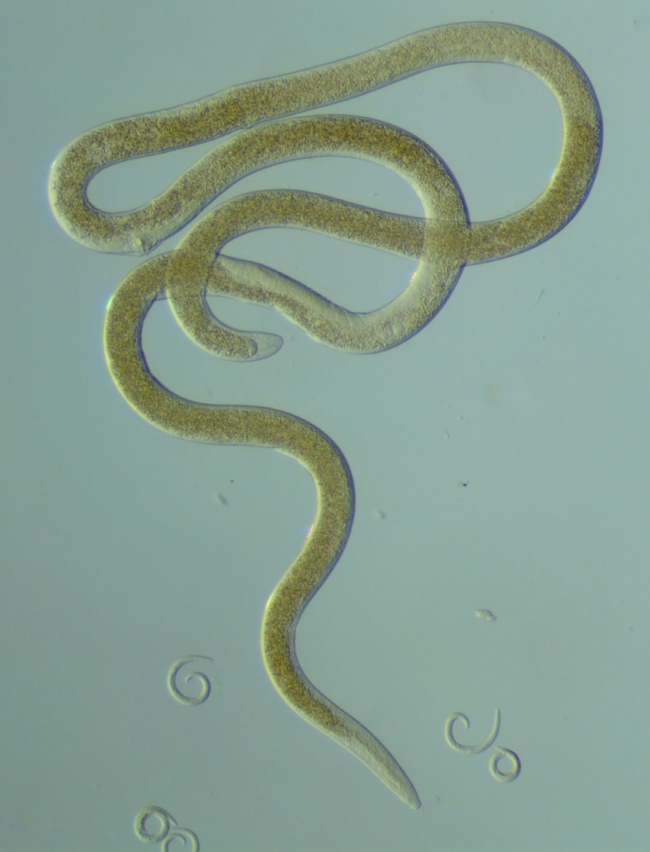
nematodes
Posted on
Wednesday, July 31, 2019 at
6:29 AM
There are 4,000 species of earthworms grouped into five families and distributed all over the world. Some grow uo to 3 feet long, while others are only a few tenths of inches. We call them nightcrawlers, field worms, manure worms, red worms and some people call them little diggers.
In California, we have some native species of earthworms, but in many cases non-native introduced species have come to dominate. The predominant native species belong to the Argilophilus and Diplocardia while many of the non-native are of European in origin in the Lumbricidae family. Many of these non-natives were probably introduced by settlers bringing plants from home, which had soil containing the worms. A survey of California earthworms by the US Forest Service can be found at:
https://www.fs.fed.us/psw/publications/documents/psw_gtr142/psw_gtr142.pdf
This is a wonderful description of earthworm biology and their occurrence in the landscape.
When digging in citrus orchards, it is common to find earthworms in the wetted mulch under tree canopies. Many of our citrus orchards were initially established by “balled and burlap” nursery trees that brought worms along with the soil. In the case of many avocado orchards, on the other hand, it can be rare to find earthworms in orchards. Most avocado orchards have been established since the 1970s when potting mixes and plastic liners were the standard practice and worms were not part of the planting media. Even though there is a thick leaf mulch in avocado orchards, the worms have not been introduced, and it is rare to find them.
Numerous investigators have pointed out the beneficial effects of earthworms on soil properties. One of the first of these observers was Charles Darwin who published Earthworms and Vegetable Mould in 1881. He remarked on the great quantity of soil the worms can move in a year. He estimated that the earthworms in some of his pastures could form a new layer of soil 7 inches thick in thirty years, or that they brought up about 20 tons of soil per acre, enough to form a layer 0.2-inch-deep each year.
Earthworms, where they flourish, are important agents in mixing the dead surface litter with the main body of the soil. They drag the leaves and other litter down into their burrows where soil microorganisms also begin digesting the material. Some earthworms can burrow as deeply as 5 to 6 feet, but most concentrate in the top 6 to 8 inches of soil.
The worm subsists on organic matter such as leaves and dead roots near the soil surface. The earthworm ingests soil particles along with the organic matter and grinds up the organic matter in a gizzard just as a chicken does. This is excreted in what we call worm casts. The castings differ chemically from the rest of the soil, as they are richer in nitrogen, potassium and other mineral constituents.
Castings are a natural by-product of worms. When added to normal soils in gardens or lawns, they provide the same kinds of benefits as other bulky organic fertilizers. Castings today are not commonly used as fertilizer by commercial plant growers because of their cost relative to other fertilizers. However, castings are used by some organic growers and are sold commercially as a soil amendment or planting medium for ornamental plants grown in pots.
The physical soil churning process also has several important effects:
-Organic residues are more rapidly degraded with the release of elements such as nitrogen, sulfur and other nutrients.
-Some of the inorganic soil minerals tend to be solubilized by the digestive process.
-Extensive burrowing improves soil aeration.
-Burrowing can improve water penetration into soils
-The earthworm carries surface nutrients from the soil surface and imports them into the root zone of the plant.
Although earthworms are considered beneficial to soil productivity, few valid studies have been made to determine whether their presence will significantly improve plant growth. This may seem odd since many of us have learned from childhood that worms are good. It is something like the chicken and the egg analogy. The conditions that are conducive to earthworms are also ideal for plants. Both plants and worms need temperatures between 60 and 100 degrees F for good growth; both need water, but not too much or little; they both require oxygen for respiration; and they do not like soils that are too acid or basic or too salty. By correcting soil conditions that are unfavorable for one will also improve the outlook for the other. The earthworm is a natural component of the soil population. If the soil is properly managed this natural population will thrive. In this sense, the presence or absence or earthworms can be an indicator of the "fertility" of one's soil.
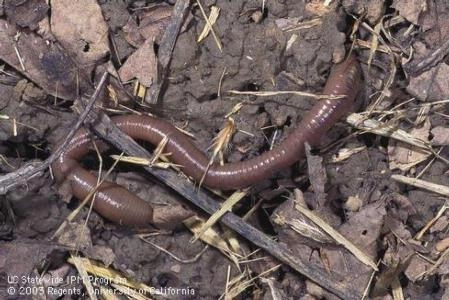
earthworm
Posted on
Friday, April 28, 2017 at
11:01 AM
Tags:
biology (1),
drought (44),
earthworms (2),
fertility (2),
fertilizers (7),
fuerte (1),
grapefruit (26),
Hass (4),
irrigation (165),
leaves (3),
lemon (106),
mandarin (71),
mold (1),
mulch (28),
nutrients (25),
organic matter (7),
ornage (4),
pollution (1),
salinity (15),
soil (95),
water (68),
worms (6)
This bulletin applies to avocado and citrus too.
DuPont Pioneer researchers have discovered a protein from a non-Bacillus thuringiensis (Bt) bacterium source that exhibits promise as an alternative means for controlling corn rootworm in North America and Europe. Science Magazine published the finding this week. “This research represents a breakthrough for addressing a major challenge in agriculture,” said Neal Gutterson, vice president, Research & Development, DuPont Pioneer. “We have discovered a non-Bt protein that demonstrates insecticidal control of western corn rootworm with a new and different mode of action than Bt proteins currently used in transgenic products. This protein could be a critical component for managing corn rootworm in future corn seed product offerings. The work also suggests that bacteria other than Bt are alternative sources of insecticidal proteins for insect control trait development.” An extremely destructive corn pest, corn rootworm larvae and adults can cause significant economic loss for growers. The current biotech approach for insect control sources proteins from Bt soil bacteria. Field-evolved insect resistance to certain Bt proteins has been observed in some geographies. Another Pioneer study related to non-Bt insect control, recently published in Scientific Reports, shows how RNA interference (RNAi) can be applied to control corn rootworm feeding damage. RNAi is a biologically occurring process that happens in the cells of plants, animals and people. By employing the RNAi process, a plant can protect itself by carrying instructions that precisely target specific proteins in pests. - See more at: https://www.morningagclips.com/discovery-of-potential-insect-control-traits/?utm_content=articles&utm_campaign=NLCampaign&utm_source=Newsletter&utm_term=newsletteredition&utm_medium=email#sthash.nF99oEWC.dpuf
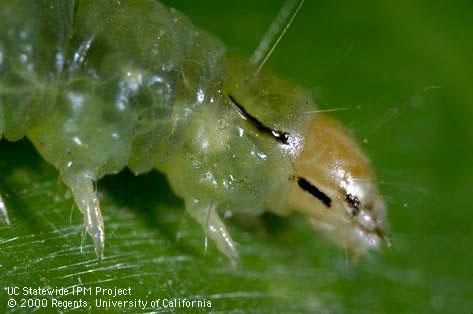
amorbia 1
Posted on
Monday, September 26, 2016 at
9:48 AM






